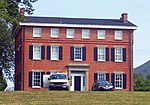Sugarloaf Mountain (Dutchess County, New York)

Sugarloaf Mountain is a 900-foot (270 m) peak located in the town of Fishkill near the Hudson River and Breakneck Ridge. One of several similarly named mountains in the U.S. state of New York, it is part of the Hudson Highlands, located entirely within Hudson Highlands State Park. It can be climbed via the Wilkinson Memorial Trail, which has its western trailhead a mile (1.6 km) from the summit on New York State Route 9D along the Hudson River, opposite the Breakneck Ridge station on Metro-North Railroad's Hudson Line. The trail climbs gently at first but then steeply as it approaches the summit plateau. At either end there are panoramic views over the river's Newburgh Bay, surrounding mountains and nearby communities.
Excerpt from the Wikipedia article Sugarloaf Mountain (Dutchess County, New York) (License: CC BY-SA 3.0, Authors, Images).Sugarloaf Mountain (Dutchess County, New York)
(deer path),
Geographical coordinates (GPS) Address Nearby Places Show on map
Geographical coordinates (GPS)
| Latitude | Longitude |
|---|---|
| N 41.458333333333 ° | E -73.975 ° |
Address
(deer path)
(deer path)
12520
New York, United States
Open on Google Maps











